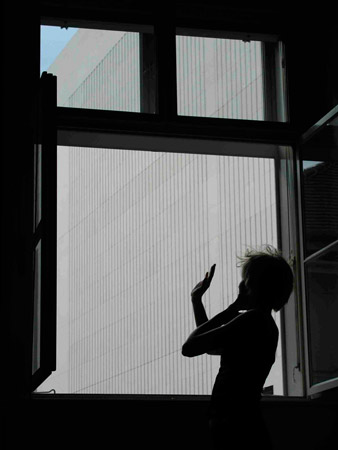No matter how many times you’ve been to Hall G, as you descent into the set of Nicht im Traum – Kleistsche Bewegungsbilder, you would not have recognised the space.
Rose Breuss created four sets of seats in each corner of the hall, with a huge alley between them. The orchestra lined all one side between two facing sets of audience. The rest of the space was huge and open.
Barbara Kraus’s huge build for Johnny was equally ambitious but the audience was all on one side of the auditorium. She She Pop’s Warum Tanzt Ihr Nicht ingeniously divided the Hall G space into different rooms with simultaneous action. Various shows have left us sitting on the floor surrounded by curtains. But sitting us facing one another like in a sports arena was new.
Nicht im Traum – Kleistsche Bewegungsbilder began with lowered lights and the entrance of an immaculately clad string orchestra of about twelve. The strings were accompanied by a single synthesiser. Hannes Löschel’s score was strange and haunting, throughout the piece, unlike anything you’ve ever heard before.
From the beginning the music was accompanied by whispered text, taken from the original 1810 play on which the Rose Breuss’s dance production was based. Most of the time the voices seemed to be recorded but to good effect the voices came live. Again most of the text was in German – I wasn’t certain if one should understand it all – but when Magdalena Chowaniec delivered a beautiful reading of a section in English on a microphone just two metres from me, it was clear that we are not supposed to try to catch every word and decipher every phrase. It’s impressionistic texture, part of the musical score. Individual words should register and trigger associations.
This is the second time I’ve heard whispers as an integral part of a dance score. The first time was in Laurie Anderson’s composition for Trisha Brown and the Opèra de Paris O zlozony / O composite, where the voice was Polish. In both cases, the treatment of voice as instrument was highly effective, triggering deep associations as one hears the words one needs to hear in the whisper.

Credit: Fliederbusch.
This is photo is one of two that TQW and Rose Breuss provided for this wonderful show.
They should both be ashamed. Dance audiences deserve better.
See previous entry on dance publicity photographs.
The dance began with tortured movements, contorting the whole body of Anna Nowak and some of the men. The movement was strong and disturbing, a clear statement that this group came out to dance and not to pose around the stage.
Afterwards we went into some quieter cycles of movement. Individual dancers came out of the shadows to join the others and then would disappear seamlessly back into the audience. The movement was almost continuous for the first half hour.
There was some very strange business with clothes, sometimes strewn across the stage, sometimes given to individual dancers to put on. Most of the clothing sections were led by Agata Maskiewicz who showed outstanding concentration and gravity in what seemed like a nonsensical activity.
This may be the first modern dance performance I’ve seen where the clothes went on instead of coming off. It wouldn’t have been a catastrophe if things had gone the other direction as Rosa Breuss assembled a gorgeous troup. All are strong dancers, with great individuality.
Agata Maskiewicz is tall and dark and elegant. She danced mainly with Julia Mach who is tall and blonde and equally elegant. Anna Nowak in the lead role of Käthchen von Heilbronn was outstanding throughout, most so delivering a ten minute floor routine towards the end. In the floor routine as in most of the piece, Nowak was very competently shadowed by Magdalena Chowaniec. Apparently, Chowaniec represented Käthchen’s dream.
While their roles were less memorable, Aldexander Deutinger, Sebastian Zgorzali, Vladyslav Benito Soltys, Robert Przbyl and Sabile Rasiti all put in solid performances. Rosa Breuss seemed less interest in the movement of the men than that of the women – which was understandable given the focus of the piece on the soul of a single woman.
I felt given the inventiveness of what she did with the female solos and duets she could have done more with duets between men and women.
Other strange things to note were the quality of the personal grooming of the dancers. They all came with their hair properly cut and set, their makeup was natural and attractive, and for the most part they even smelled fresh. A wonderful change from the grotty and ugly look so popular in Tanzquartier shows of the last year. How many uncombed dancers in black tshirts and black jeans do we need to see in a year?
In the first half of the show there was hardly a t-shirt of a pair of jeans to be seen. The sense of costume lifted the whole piece. Unfortunately in part two and particularly on the men, we faced many more t-shirts and the general aesthetic tone of the piece fell.
In fact the intensity of the choreography fell off altogether. There were points between 30 minutes and 60 minutes where one wondered where we were going with this and the movement took on a sort of dull sameness. The pace fell of altogether.
After the show, I learned that Rosa Breuss and the dancers had only six weeks to rehearse this whole complicated work of art.
While the music, the concept and the casting were perfect, the difficult subject matter required more rehearsal time. Many of the sections felt like rough sketches – precise emotional moments were lacking. But it’s difficult to get the space for long enough to rehearse properly. Breuss and her dancers had only two days rehearsal in Hall G. Budgets don’t allow for extended off-site rehearsal either – not unless the dancers are prepared to work for a few weeks for free, which isn’t something that one can count on.
I faced a similar dilemma with Lapinthrope where we scheduled to shoot (had begun shooting) while the performance wasn’t really set. I cancelled the shoot and took the dancers and Kathleen Rea back into rehearsal for two months, more or less at my own expense (it wasn’t in the budget) with a help from Kathleen and Anna (lots of extra work at minimal extra cost). The difference was art and nuance as opposed to rough idea. But one can’t count on being able to do that. That decision to finish the work in the end put Decadence Films so far behind economically that it took years to recover.
I hope Breuss gets some more funding to restage or tour Nicht im Traum – Kleistsche Bewegungsbilder as it will only get better with more rehearsal and more performance.
Overall, highly recommended. Exceptional staging, excellent dance, innovative score, superb cast.

